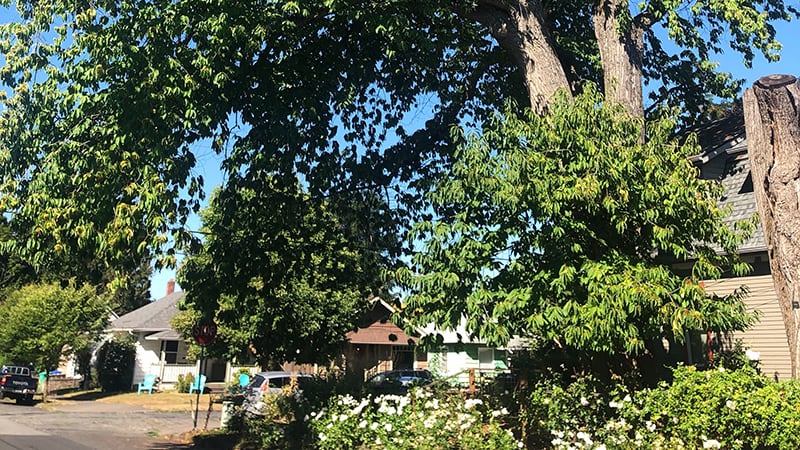The tree canopy in Portland has shrunk since 2015, a new report by the city of Portland found.
It shrank from 30.7% to 29.8% in a five-year span—the equivalent of 823 acres.
No city land was spared from the loss: Business and residential areas, industrial complexes and undeveloped space such as parks all lost trees, but no landscape was hit harder than residential areas, where 64% of the total loss occurred. Residential areas are a little over 30% canopied.
One important note: The numbers are within the margin of error, Portland Parks and Recreation acknowledged, meaning that they could be statistically insignificant, a possibility that likely won’t be settled until the next report five years from now.
But if those numbers are corroborated by future reports, the findings illustrate what could be a dangerous trend. Trees absorb carbon and help cool blacktopped, developed urban neighborhoods. That’s important as temperatures rise; witness last year’s heat wave in Portland that killed 54 people.
Four ZIP codes east of 42nd Avenue accounted for nearly a quarter of the city’s heat deaths last summer. That’s the exact area Portland State University researcher and climatologist Dr. Vivek Shandas warned four years ago would kill Portland’s most vulnerable residents if unprecedented heat descended on Portland.
Last summer Shandas took WW to the hottest place in Portland: an intersection in the Lents neighborhood, and one of the deadliest ZIP codes during the heat wave. Shandas explained why it reached higher temperatures than other parts of the city. The biggest factor? Lack of trees and foliage. The tree canopy in East Portland covers only 20% of land. West of the river, 46% of the city is canopied.
In Lents, tall commercial and residential buildings with few trees mean apartments have no refuge from the sun’s heat. Dark pavement and wide streets absorb the heat, and then release it into the surrounding area over a span of hours. Closely clustered buildings mean no breeze and stagnant, hot air.
The shrinkage reported by the parks bureau this week is the first time Portland’s tree canopy has dwindled in a span of five years since the city started tracking tree cover in 2000.
The report, conducted by the parks’ Urban Forestry team, did not address reasons for why the tree canopy had shrunk, nor did it map out the areas of the city most affected. The bureau says in the report that deducing why the canopy has declined “requires additional study and would allow for more informed strategies for meeting tree canopy goals.” Possible reasons the city hypothesized: inclement weather events, trees being chopped down for development, and tree death caused by pests.
It appears the bureau was surprised by the results.
“Canopy growth has slowed or reversed in the past 5 years. Interestingly, this time period coincides with the 2015 adoption of improved regulations for tree preservation and removal with Portland’s tree code, Title 11,” the report reads. “Despite these new rules resulting in the preservation of thousands more trees than would have been preserved in previous years, the city was still not able to realize the gains in tree canopy cover seen in the early periods of this study.”
The city has had an ongoing goal for 15 years now of increasing the city’s overall tree canopy to 33.3%.

